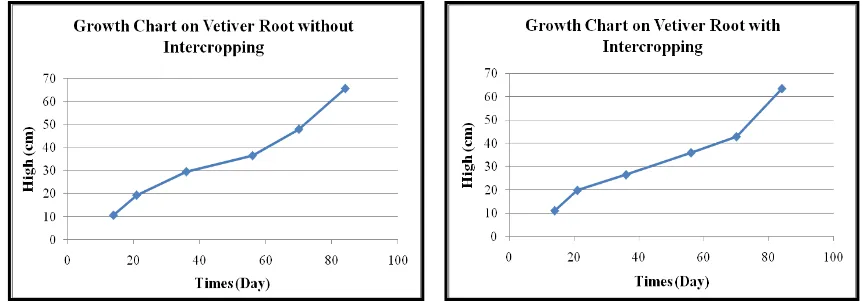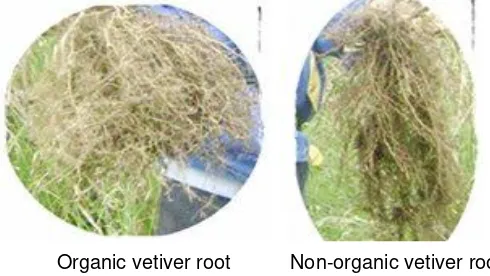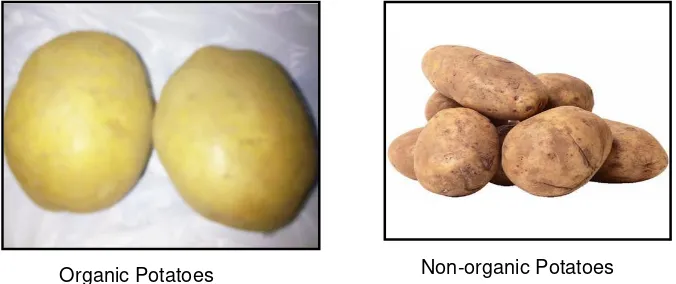http://dx.doi.org/10.17503/Agrivita-2012-34-1-p060-066
GROWTH PROCESS OF ORGANIC VETIVER ROOT WITH POTATO AS
INTERCROPPING PLANT
Asep Kadarohman1), Ratnaningsih Eko S.1), Gebi Dwiyanti, Lela Lailatul K.1*), Ede Kadarusman, and Ahmad Nur F. 2)
1)
Department of Chemistry Education, Faculty of Mathematics Education and Sciences, Indonesia University of Education, Bandung
Jl. Dr. Setiabudhi No. 229 Bandung 40154 West Java Indonesia 2
) UKM of Vetiver Oil in Samarang, Garut
Jl. Raya Kamojang Samarang Garut 44161 West Java Indonesia *) Corresponding author Phone: +62-22-2000579 E-mail: lailatul_khumaisah@yahoo.com
Received: June 2, 2011 /Accepted: December 12, 2011
ABSTRACT
Vetiver oil (Vetiveria zizanoides) is one of Indonesia main export commodities. Vetiver root is perennial plant and generally planted with vegetables as intercropping plant. Increasing the selling price of vetiver oil can be done by transferring the production of conventional vetiver oil (non-organic) to organic vetiver oil. Demonstration of land used was one hectare, which 2,000 m2 for planting vetiver root with potato (Solanum tuberosum) as inter-cropping plant and 8,000 m2 for vetiver root without intercropping, in Sukakarya-Samarang, Garut. The planting used goat and cow dung as manure, distillate water of vetiver oil and liquid bio-pesticide as pesticide. Variables studied included plant height, number of leaf and crotch. In the first quarter of the years, the number of leaf and crotch of vetiver root with intercropping was better than vetiver root without inter-cropping. However, there was not significant difference for plant height of vetiver root, both with and without intercropping. Products of organic potato as intercropping plant of vetiver root were less than those of non-organic potato, but the latter had a better texture and durability. Keywords: Vetiveria zizanoides, Solanum
tube-rosum, intercropping, organic farming
INTRODUCTION
Indonesia is the second largest country after Haiti as vetiver oil exporter in the world and in 2010, it became the first exporting country after the earthquake in Haiti. Vetiver oil is obtained from distillation process of vetiver
root. Vetiver oil is widely used for perfumes, cosmetics, fragrance soap, anti-inflammatory, as well as insect repellent and deterrent (Tarigan, 2006).
Vetiver root is an annual plant and generally planted with vegetables as inter-cropping plant such as cabbage, potato, and peanut. Different from vetiver root, intercropping plant needs a fertilizier and pesticide to grow optimally. The farmer usually uses a chemical fertilizer and pesticides, but organic farming systems need an organic fertilizer and bio-pesticides. Compost and manure from dung are examples of organic fertilizer, where compost was derived from plant residues (Indarto, 2008). Therefore, the intercropping plant needs replacement of synthetic fertilizers and pesti-cides to organic fertilizers and bio-pestipesti-cides. Because the eliminating vegetable as inter-cropping plant of vetiver root will reduce farmers' income. However, this step poses a problem how about growth process of organic vetiver root and vegetables as intercropping plant. Then, we conducted a research about the growth process of vetiver root with potato as intercropping plant.
In demonstration plot (demplot), planting organic vetiver root uses potato as intercropping plant because it has a higher economic value
The instruments used were a set of tools for the process of land preparation, planting, weeding, bio-pesticide spraying, and harvesting. Among them were hoes, machetes, knives, squirt gun, tape measure, scales, and stationery.
Methods
1. Land Preparation
One hectare of land was prepared by raising bed system (coil) with the height, width, and distance between scrolls of 40, 110, and 30 cm, respectively. Selection of the land had to comply with the requirements for organic crops, one of which was not polluted by the surround-ing plants.
The location of land area of the region Kampung Legok Pulus Sukakarya Village, Samarang-Garut, West Java is center of vetiver oil industry in Indonesia. It is located on the highest plain in the region, isolated from other vetiver root and is not passed by the flow of water from other lands.
Demonstration plot of land used was one hectare, which consisted of 2,000 m2 for planting
vetiver root with potato as intercropping plant and 8,000 m2 for vetiver root without inter-cropping. Planting potato as intercropping was done on May 30, 2010 and the planting of vetiver was finished on June 5, 2010. Figure 1 shows the scheme and the land area of organic vetiver root with and without intercropping. Planting and Fertilization Process
The first step, after the land area ready for use, was the process of planting potato as an intercropping of vetiver root. The space between seedlings was 30 cm. Moreover, fertilization and spraying with bio-pesticide were applied. The next step (after 1 week) was planting vetiver root. The distance between vetiver roots was about 40 x 60 cm. The planting used goat and cow dung as manure, distilled water of vetiver oil and liquid bio-pesticide as bio-bio-pesticide. The amount of manure used was 50 bags for every 1000 m2 conducted at the beginning of the planting process.
8,000 m2 for vetiver root without intercropping
2,000 m2 for planting vetiver root with potato as intercropping
2. The Process of Weeding and Bio-pesticide Spraying
Process of weeding was done around age 30 and 50 days for potato and at the age of 3 months or more for vetiver root. The bio-pesticide spraying process was only applied on potato. Bio-pesticide type used was a mixture of several liquid bio-pesticides. One liter of each bio-pesticide could be used for two-time spraying. Each spray was mixed with about 80 liters of water then sprayed on potato, and the distillate water of vetiver oil was also used because vetiver was effective bio-insecticides (Henderson et al., 2005; Maistrello et al., 2001; Zhu et al., 2004; Jain et al., 1982).
3. Variables Examined
Variables studied were height, number of leaf and crotch for vetiver root and susceptibility to pests and diseases, products, the skin surface, size, and durability for the potato.
RESULTS AND DISCUSSIONS
Growth Process of Vetiver Root
To know the difference of a vetiver root grown with and without intercropping, three variables were observed, including plant height,
number of leaf and crotch. Observations were done at a specific period of time. The obser-vation is shown in Figure 2, 3, and 4.
Figure 2 indicates that the height of vetiver root with and without intercropping did not have significant difference. Both reached the average height of 60 cm on the 84th day after planting (approximately 12 weeks/3 months). The height shows that organic vetiver root with and without intercopping grew normally. The intercropping method did not interference the growth of vetiver root. Observation about number of leaf on vetiver root with intercropping was better than that without intercropping, as shown in Figure 3.
Differences between the leaves were observed from day 36 after planting. The differences were in line with the increasing age of the plant. At the age of 84 days, the average number of leaf on vetiver root with intercropping was 112 sheets, while the vetiver root without intercropping was 98 sheets for each tree. Thus, intercropping method could better the growth of vetiver root, where it was also supported by the number of crotch, as shown in Figure 4.
Figure 3. The number of leaves on vetiver root with and without intercropping
Figure 4. The number of crotches on vetiver root with and without intercropping
Figure 4 shows that the number of crotch on vetiver root without intercropping was relatively constant from 28th day with the average 8 crotches each tree, while vetiver root with intercropping had more crotches, reaching an average of 9 crotches each tree.
According to these variables, the growth of vetiver roots with intercropping was better than vetiver root without intercropping. Phy-sically, organic vetiver root with intercropping was fresher than that without intercropping (Figure 5). Vetiver root is an annual plant and the minimum ingathering is 1 year old or more.
The organic vetiver roots (with and without inter-cropping) have several differences compared to non-organic vetiver root.
Figure 5. Compare between vetiver root with and without intercropping
Figure 6. Organic and non-organic vetiver root
Product of Intercropping
Planting organic vetiver root uses potato as intercropping plant because potato has a higher price than other vegetables. Results showed that the growth of organic potato was slower than non-organic potato. This was probably caused not only by the replacement of fertilizer and pesticide synthesis by manure from dung and bio-pesticide, but also possibly by weather factors.
The weather with high rainfall rotted the potato leaves. Late blight,caused by the fungus Phytophthora infestans, was very damaging and difficult to control. Infection on all leaves caused the plant to die (Purwanti, 2002). Besides, the disease could also attack the stems and tubers in the ground (Djafaruddin, 2000).
Late blight of potato production can be lowered to 90% of the total potato production in
a short time (Purwantisari et al., 2008). Using the distillate water of vetiver oil to kill fungi has not been effective, because the concentration of distillate water of vetiver oil is too high. According to Juarez et al. (2000), a fungicide is commonly used to eliminate blight. In addition, Nadia et al. (2007) says that a control of late blight depends on the use of fungicides.
Product of organic potato is less than non-organic potato. However, the quality of organic potato is better, seen from the texture and durability as shown in Figure 7 and Table 1. The growth of potato can be hampered by the attack of diseases and low soil nutrition (Ngakou et al., 2006). Sutanto (2002) said that organic product was more delicious and healthier than non-organic product.
Vetiver root with intercropping Vetiver root without intercropping
Figure 7.The surfaces of organic and non-organic potato
Table 1.Monitoring of process storage
Types of potato Total rot potato in week (%)
I II III IV V VI VII VIII IX X
Organic - - - 16.7 16.7 16.7 16.7 16.7 16.7 16.7 Non-Organic 16.7 50 100
Remarks: Total potato observed 6 units
Figure 7 shows that the organic potato had clearer and smoother surface compared to non-organic potato. This condition is preferred by consumers, so it will have a higher price.
According to Table 1. the organic potato had a better durability than non-organic potato harvested from the same region and seeds. It is shown that all non-organic potato rotted in the 3th week. Meanwhile. the organic potato started to rot in week 4 with only 16.7%.
The differences of organic and non-organic potato are shown in Table 2.
Table 2.Differences of Organic and Non-organic Potato
Variable Organic potato Non-organic Potato
Growth slower faster
Pests and diseases
bad endure good endure
Product low quantities great quantities
Surface clear. smooth dirty. rough
Size small big
Durability good bad
Most industrial countries have potato productivity of up to 40 ton/ha. This is much different from that in Indonesia, which is still relatively low, between 14 and 16 ton/ha. One of the factors resulting in the low productivity is the use of low quality seeds. The seeds are frequently obtained from previous harvest, which are commonly not virus free (Dwiati, 2011). In this study, organic potato producted is 437 kg/2000 m2 (0.2 hectare), and generally non-organic potato producted in Garut ± 6,000 kg/0.2 hektare. This indicated productivity of organic potato is very low compared non-organic potato.
CONCLUSIONS
Organic vetiver root with intercropping had more leaves and crotches than that without intercropping in the first quarter of the year. However. it did not bring a significant difference in the height of organic vetiver root. both with and without intercropping. Therefore vetiver root planted with intercropping can be done and generally the growth process of vetiver root is uninhibited. The appearance of organic vetiver root was denser and more interest than
organic and no black spots were found on organic vetiver root. Product of organic potato as intercropping plant of vetiver root is less than non-organic potato. but the organic potato has a better texture and durability.
REFERENCES
Djafaruddin. 2000. Dasar-dasar pengendalian penyakit tanaman. Bumi Aksara. Jakarta. pp.49.
Dwiati, M. and S. Anggorowati. 2011. Induction of in vitro culture of potato microtuber by using alar and dark photoperiod application. AGRIVITA. 33(1): 47-52. Henderson, G., D.O. Heumann, R.A. Laine, L.
Maistrello, B.C.R. Zhu and F.Chen. 2005. Extract of vetiver oil as repellent and toxicant to ants, ticks and cockroaches. United States Patent 6906108. B2.1-13. 12 claims. 4 drawing sheets.
Indarto, A. 2008. Pengaruh penambahan produk pupuk cair slurry terhadap laju per-tumbuhan tanaman mentimun (Cucumis sativus L). Skripsi Sarjana pada FTSP UII. Yogyakarta. tidak diterbitkan. pp. 14. Jain, S.C., S. Nowicki, T. Eisner and J.
Mein-wald. 1982. Insect repellents from vetiver oil: I. Zizanal and Epizizanal. Tetrahedron Letters. 23(45): 4639-4642.
Juarez, H.S., J.R. Amaro, M.D. Rivera, A. Parraga and R.J. Hijman. 2000. The Effect of Nitrogen Fertilization on Potato Late Blight in the Field. CIP Program Report. p. 69-76.
Maistrello, L., G. Henderson and R.A. Laine. 2001. Efficacy of vetiver oil and noot-katone as soil barriers against formosan subterranean termite (Isoptera: Rhino-termitidae). Journal of Economic Entomology. 6(94): 1532-1537.
Nadia, G., G. El-Gamal, F. Abd-El-Kareem, Y.O. Fotouh, Nehal, S., El-Mougy. 2007. introduction of system resistance in potato plants against late and early blight disease using chemical inducers under greenhouse and field conditions. Research Journal of Agriculutre and Biological Science. 3(2): 73-81.
Ngakou, A., C.Megueni, D. Nwaga, M.R. Mabong, F.E. Djamba and M.Gandebe. 2006. Solanum tuberosum (L.) responses to soil solarization and arbuscular mycorrhizal fungi inocu-lation under field conditions: growth, yield, health status of plants and tubers. Middle East Journal of Scientific Research. 1(1): 23-30.
Purwanti, H. 2002. Penyakit hawar daun (Phytophthora infestans (Mont.) de Bary) pada kentang dan tomat: identi-fikasi permasalahan di Indonesia. Buletin AgroBio.5(2): 67-72.
Purwantisari, S., R.S. Ferniah, B. Raharjo. 2008. Pengendalian hayati penyakit lodoh (busuk umbi kentang) dengan agen hayati jamur-jamur antagonis isolat lokal. Bioma. 10(2): 13-19.
Sutanto, R. 2002. Penerapan Pertanian organik: pemasyarakatan dan pengembangan-nya. Kanisius, Yogyakarta. pp. 218. Tarigan, N. 2006. Jenis-jenis serangga dan
intensitas serangannya pada berbagai pola tanam akar wangi. Buletin Teknik Pertanian. 11(1): 1-4.



